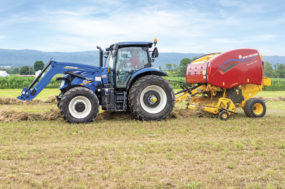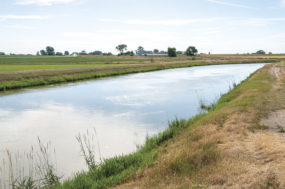I told him that it would not fit me; that I was too tall to get inside one and sit up. He allowed as how that was my problem and that we needed to get one anyway.
This is the same kid who got me in trouble at the house in the past when we went driving in my 1979 Mazda RX7. (You explain Detroit to me.
I don’t fit in the Mustang or the Camaro, but I can get my oversized carcass in the vintage RX7, which comes from Japan.)
He announced to the whole household that “Grandpa stopped to talk to the nice policemen who were on motorcycles.” The speedometer is dead on.
When it says 63, the radar also says the car is going 63. The road was posted for 55 and the local troopers usually allow nine over unless there is another problem. There was not.
Years back, I was in the midst of a fight with my back. I had a dairyman who was to the point of out of hay. I could drive the truck but I could not lift a bale of hay.
One of my friends volunteered his son, who was a senior in high school at the time. I drove the truck, my brother Lyle, who usually fed the hay elevator, stacked the load. My friend’s son and my son Dan, who was about 12 at the time, fed the elevator.
The procedure to feed the elevator is rather simple. Considering a narrow bed stack that is nine layers high, the first order of business is to break into an end of the stack and then take it down three layers at a time, putting one bale at a time on the elevator.
With experience you can get two out of three bales from the stack onto the elevator without ever bearing the full weight of the bales. Kind of just snag the bale with the hay hooks, give it a jerk and guide its fall onto the bale conveyor.
After about six bales, you let the elevator empty and then move it towards you and load it again. To move the elevator regularly means that you never take a step carrying a bale of hay.
The man on the truck is moving the same direction and is also ready to move the elevator after about six bales. On a good day with good bales and no complications, it took about an hour and a half to load the truck and trailer with about 700 bales.
The usual complication with green help was to get the guys to understand how much work was saved by moving the elevator closer to the work regularly.
Bob’s son realized soon after they started work that he needed a higher education. I think this experience clinched his decision to go on to college after graduating from high school.
My 12-year-old had handled hay bales before and spent most of the time telling the bigger kid to stay out of his way.
About three hours later, one very exhausted big kid and one very tired but proud smaller kid loaded into the cab of truck with the hay now loaded. The one with the experience moved most of the hay, while the older fellow worked harder.
The grandkids learned how to make me miss turns. It’s called bugging Grandpa for a story. Then they laugh when Gran interrupts the story to tell me that I just missed the turn.
It is very interesting to note which stories they remember and comment on later. Tonight a comment was made about the time Grandpa threw the cow down.
This was from back in the era when I was doing those things that I remember now, for which bone or joint hurts when the weather changes.
My young bride and I were bringing heifers through the milk parlor before they calved and giving them a little grain so that after they had calved, they would know where they were going and that there was a treat waiting for them.
Most Holstein heifers pick up on the idea that if they go where you want them to go, you will go away and stop bothering them.
Every now and again there is one who is mentally challenged, and then there is the one who is contrary. One of these took exception to being guided into the milk parlor, and with her head and neck she slammed my bride against the wall of the holding corral and then ran to the back of the enclosure.
There she turned around and was met by someone who took exception at the way she had treated the lady. I grabbed her by the head and with an enraged twist threw her down in the same manner a bulldogger at the rodeo throws a steer.
Very strange. When she got her feet back under her, she knew exactly where she needed to go and got her obstinate carcass there without further discussion.
I had the oldest boy with me when he was just getting good at talking. We were beside the enclosure that the horses on the ranch lived in.
I don’t know what it was that the horses had been licking or eating, but a bright yellow pollen or seed pods covered their tongues. Mitch turned around and excitedly exclaimed, “Daddy, horsies got lellow tongues!”
This same boy loved to jump off of things to be caught by myself or his grandfather. We had to have a serious discussion with Mitch when Dad told me that one day he heard Mitch call out “Grandpa! Catch!” and the boy was already airborne. Dad said he just barely caught him. After that Mitch made sure someone was paying close attention before he jumped.
Way back in history, man found it more interesting to feed hay and grain to the cow and then eat the cow than to eat the hay and grain himself. It becomes an art form to select and cook the various cuts of meat from the noble bovine.
Now, I don’t see myself as cheap, but the grandkids think I like to hear the buffalo bellow as the nickels slip between my fingers. I save the better cuts of meat for special occasions and do very well with chuck steak for normal barbeques.
I noticed in my community, which has a large Hispanic population, that the very thin-cut beef that is popular in their cookouts is often even less expensive than hamburger.
The procedure is to quickly sear it on both sides, then load up a tortilla with a piece of this beef and onions, peppers and salsa. I have been a guest at many of these feeds over the years and it’s plenty good eating.
I figured out how to cook this very inexpensive meat in a manner that my family is used to eating. I season each slice, then roll each up and lay it in a roasting pan, several rolls in a row.
Add cut-up potatoes and carrots and onions in the other end of the roasting pan, cover, and bake at 275 degrees for about three hours. It comes out very similar to pot roast and you can break up each roll with a fork.
When served, each roll is about an inch-and-a-half wide by about seven inches long. After it’s cooked, it stays rolled up. My nine-year-old grandson, eyeing his meat suspiciously, said, “Grandpa, what is this?”
Payback time. I looked him in the eye and said, “It’s a rat.” He sucked all the air out of the room before he realized I was pulling his leg. FG











